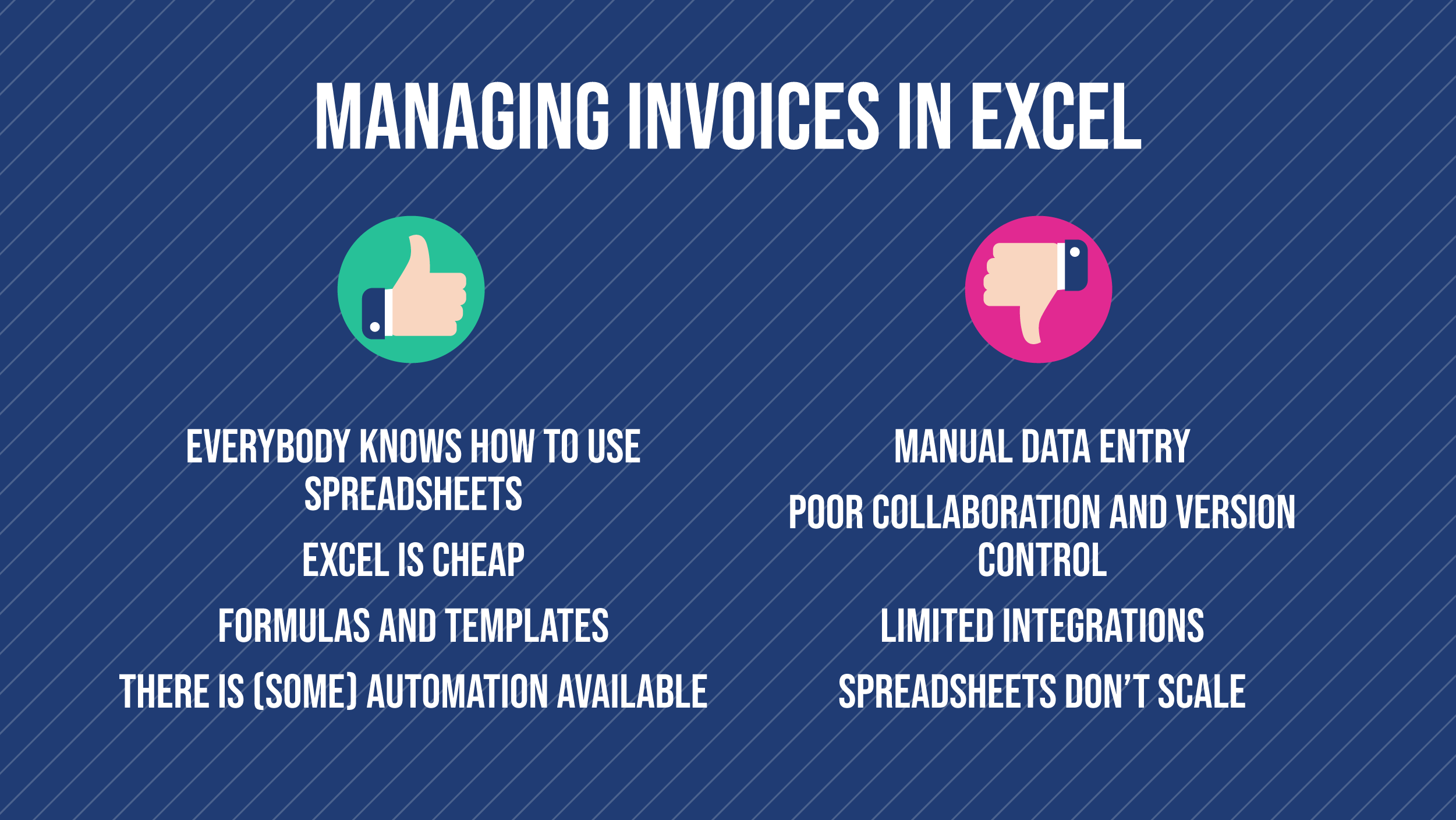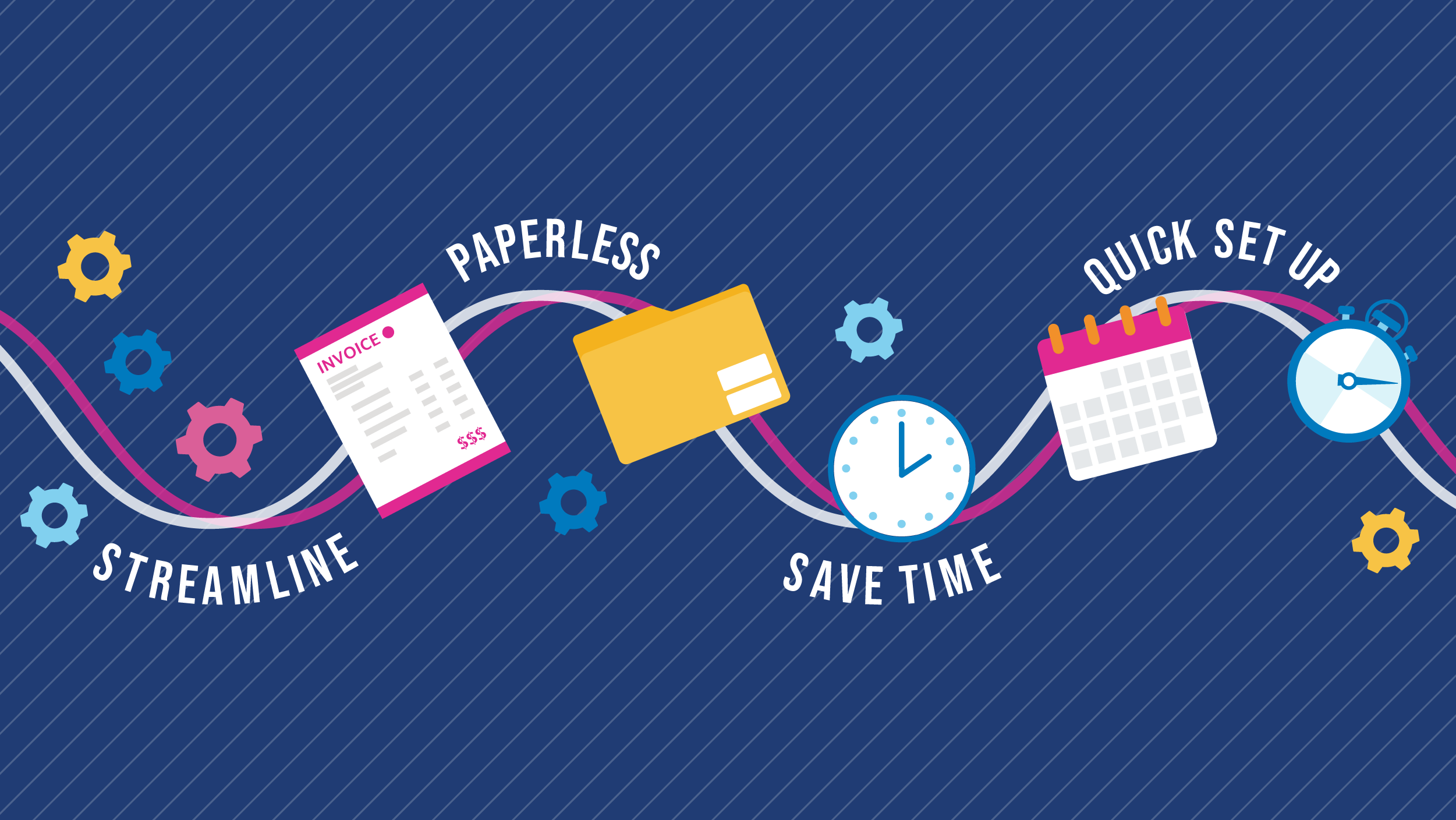Invoice Management in Excel is a Nightmare. Do This Instead

Does your business conduct invoice management processes in Excel? Are you wondering if there’s a better way to build a scalable solution for managing all those invoices?
Don’t get us wrong — Excel is an excellent all-around tool for formulas and it’s great for organization. When used properly, Excel can provide some insights into your financial system. However, it was never designed to be an invoice management system and lacks features to help you automate tasks, integrate with other tools, and collaborate with other employees and departments, which are all needed for modern AP processes.
In this post we’re going to break down the pros and cons of using Excel to manage invoices and also explore the benefits of switching to a more modern, cloud-based system for invoice management.
Pros of using Excel for tracking invoices

To be fair, there are certainly lots of legitimate reasons why you might use spreadsheets for invoice management, including (but not limited to) the following:
Everybody knows how to use spreadsheets
OK, maybe not everybody, but virtually 100% of accountants, bookkeepers, and accounts payable personnel know how to use spreadsheets. Excel has been somewhat of a gold standard in the finance industry for decades, and basically every business is using it (or Google Sheets) in some capacity.
That means there is plenty of domain expertise within your organization to lean on, as well as online tutorials that can help you figure out how to do most operations related to AP. Additionally, Excel has such widespread adoption that you can find some version of it on almost every computer in every business so it’s very easy to access.
Excel is cheap
A license for Excel, or rather the base version of Microsoft Office 365, is only $5 per user per month. And the premium version, which has upgraded security features, tops out at $20 per user per month. You’re not going to break the bank using Excel.
Formulas and templates
Since Excel has been around so long and has such widespread adoption, there are actually plenty of pre-made templates for accounts payable, such as an invoice tracking. Some templates, like this one, are even free.
The same goes for formulas—many already exist in Excel that users can leverage for their AP processes.
There is (some) automation available
With a little bit of magic, you can actually get Excel to do some AP processes automatically. This article gives an example of how Excel can automatically fill in some vendor information as you’re preparing an invoice.
There are also many other add-ons you can use to supplement the functionality of your spreadsheets. One common example is using the Mail Merge add-on with Google Sheets to help you add mailing addresses, etc.
That said, the automation possible with Excel and Google Sheets pales in comparison with what modern AP automation platforms can do, but we’re getting ahead of ourselves…
Cons of using Excel to tracking invoices
Manual data entry
There’s no getting around this one — if you’re going to use Excel for invoice processing, you’re going to have to type in the line items manually. This is not only a tedious task, it is also where most of the errors occur. It’s very difficult for a human to be 100% accurate when keying in data manually.
Apart from the actual data entry process taking more time than an automated invoice scanning system, going back to correct the errors (especially if they are passed through to the vendor) will create even more work.
Poor collaboration and version control
While both Microsoft Excel and Google Sheets offer some collaboration features, the multi-user editing feature has some notorious flaws. If two people are collaborating on a spreadsheet, only one person can edit at a time. The other person will get read-only access and a promise that Excel will notify them once the other person is done, which doesn’t always happen in a timely fashion.
You’ll also likely be shuffling these documents through email, cloud storage systems like Google Drive or Dropbox, or possibly even instant messaging — this creates more opportunities to misplace documents. Ensuring the proper access — and denying improper access — is also a challenge with this method.
Also, businesses can often end up with multiple versions of their invoice tracking spreadsheet. If this happens, you’ll have to take more time to go back and figure out which one was edited last and confirm the most up-to-date version.
Limited integrations
While there are add-ons for Excel and certain things you can integrate with Google Sheets, spreadsheets aren’t generally designed to integrate seamlessly with other financial and operational systems like your accounting enterprise resource planning software. Contrast this with the built-in integrations of AP automation platforms that can connect via API or by seamless file integrations.
Spreadsheets don’t scale
Without a doubt, this is the biggest issue with using Excel for invoice management. As we said earlier, spreadsheets can work for tracking invoices, but once the business grows to a point where your AP department is processing hundreds of invoices per month, a spreadsheet solution simply won’t work.
There are already so many challenges with growing a business, you do not want your inability to pay your vendors to be a cause of delayed growth.
We like to look on bright side of things, however, so this seems like a good opportunity to tell you, definitively, that:
There is a better way to manage your invoices.
Why Switch to an AP Automation Platform?

This is likely an entire blog post unto itself, but we will do our best to highlight just a few key benefits of using an AP automation platform to manage your invoices.
1. Streamline and automate your entire AP process
Imagine an AP department where:
- There is no data entry — all figures are pulled from digital files automatically via artificial intelligence (or scanned with OCR) and input into a centralized system
- Invoices are automatically sent to the person (or people) who need to approve them
- Invoices are automatically coded against your general ledger
- Upon approval, invoices are automatically routed to your B2B payments system or ready for payment within the same AP system
- After payment, all documents are updated between systems, and securvely archived for reference or audit later
This is not a fantasy AP department — this is a (highly summarized) description of what it’s like to work with Stampli’s AP automation platform.
For a more detailed read on what it’s like to automate your entire AP process, check out this post: Automated Invoice Processing: Getting to Light Speed AP.
2. No paper!
We’ve all thought about it, but a 100% paperless AP process is now entirely possible. Going paperless is not only good for the environment, it’s good for your sanity, too!
With a digital-only invoice management system, everything is indexed and therefore, searchable. This means no more lost or misplaced invoices sitting in a desk drawer somewhere.
A paperless invoice management system will also allow you to cut costs, which is great considering the average cost to process an invoice manually is upwards of $30.
Check out this related post to see a step-by-step guide on how to go completely paperless
3. Reduced your time to process invoices from eight days to three
Well that’s an oddly specific timeline, isn’t it? That’s because it’s real data from our friends over at Purple Innovation.
Upon implementing Stampli, Purple, an innovative comfort product company, was able to shave 5 days off their average invoice processing time.
“One of the areas in which we’ve saved the most time is in getting invoices into the system. The second area in which we’ve dramatically reduced time is in getting approvals,” says Peter Taylor, Corporate Controller at Purple.
You can read the full case study on Purple here: Purple Strengthens Controls and Speeds Invoice Processing Time with Stampli.
4. You can be up and running in weeks, not months
This is not a joke. Our award-winning success team will work with you to ensure your processes and systems from custom fields to preferences are maintained, and they can do it in weeks, not months.
Ready to learn more? Set up a time to talk with one of our AP Heroes!